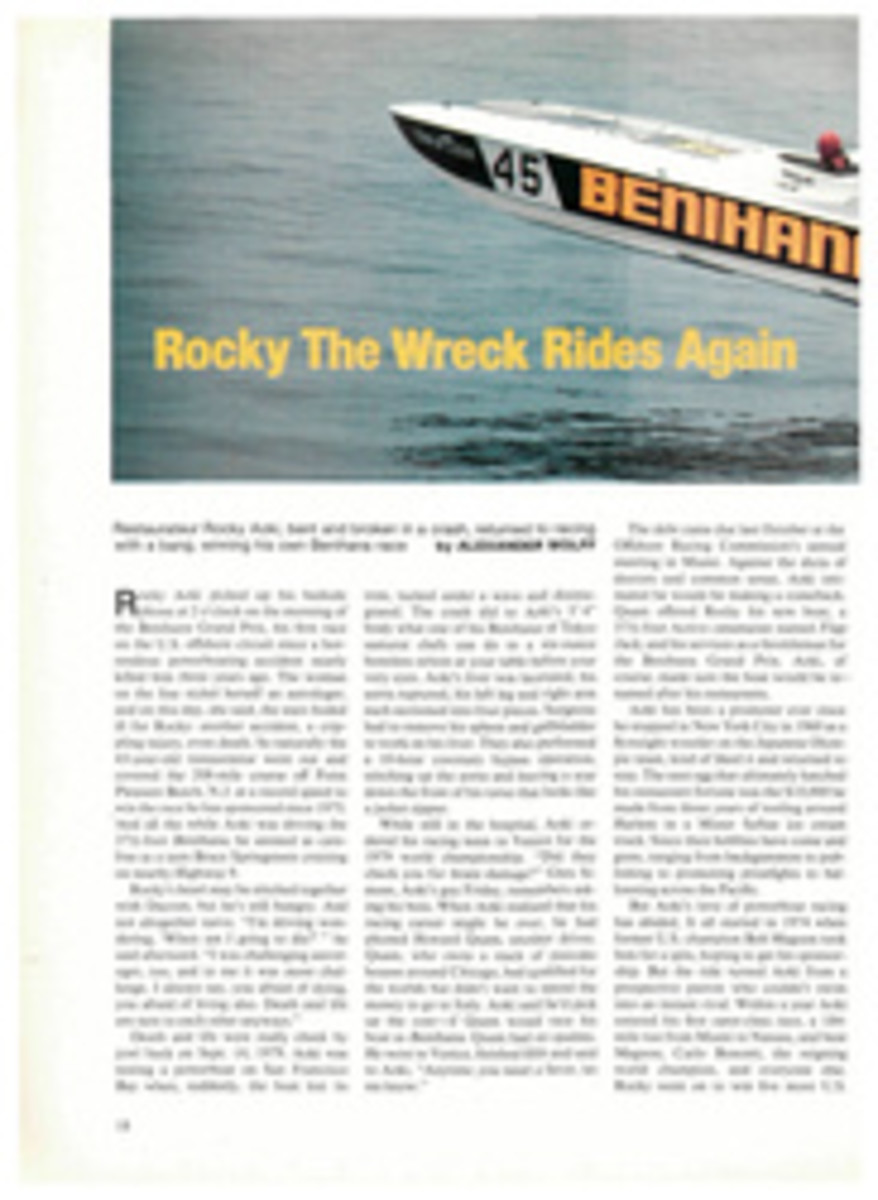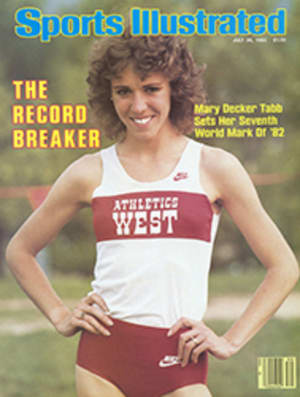
Rocky The Wreck Rides Again
Rocky Aoki picked up his bedside phone at 2 o'clock on the morning of the Benihana Grand Prix, his first race on the U.S. offshore circuit since a horrendous powerboating accident nearly killed him three years ago. The woman on the line styled herself an astrologer, and on this day, she said, the stars boded ill for Rocky: another accident, a crippling injury, even death. So naturally the 43-year-old restaurateur went out and covered the 208-mile course off Point Pleasant Beach, N.J. at a record speed to win the race he has sponsored since 1975. And all the while Aoki was driving the 37½-foot Benihana, he seemed as carefree as a teen Bruce Springsteen cruising on nearby Highway 9.
Rocky's heart may be stitched together with Dacron, but he's still hungry. And not altogether naive. "I'm driving wondering, 'When am I going to die?' " he said afterward. "I was challenging astrologer, too, and to me it was more challenge. I always say, you afraid of dying, you afraid of living also. Death and life are next to each other anyways."
Death and life were really cheek by jowl back on Sept. 14, 1979. Aoki was testing a powerboat on San Francisco Bay when, suddenly, the boat lost its trim, tucked under a wave and disintegrated. The crash did to Aoki's 5'4" body what one of his Benihana of Tokyo samurai chefs can do to a six-ounce boneless sirloin at your table before your very eyes. Aoki's liver was lacerated, his aorta ruptured, his left leg and right arm each sectioned into four pieces. Surgeons had to remove his spleen and gallbladder to work on his liver. They also performed a 10-hour coronary bypass operation, stitching up the aorta and leaving a scar down the front of his torso that looks like a jacket zipper.
While still in the hospital, Aoki ordered his racing team to Venice for the 1979 world championship. "Did they check you for brain damage?" Glen Simoes, Aoki's guy Friday, remembers asking his boss. When Aoki realized that his racing career might be over, he had phoned Howard Quam, another driver. Quam, who owns a stack of pancake houses around Chicago, had qualified for the worlds but didn't want to spend the money to go to Italy. Aoki said he'd pick up the cost—if Quam would race his boat as Benihana. Quam had no qualms. He went to Venice, finished fifth and said to Aoki, "Anytime you need a favor, let me know."
The debt came due last October at the Offshore Racing Commission's annual meeting in Miami. Against the dicta of doctors and common sense, Aoki intimated he would be making a comeback. Quam offered Rocky his new boat, a 37½-foot Active catamaran named Flap Jack, and his services as a throttleman for the Benihana Grand Prix. Aoki, of course, made sure the boat would be renamed after his restaurants.
Aoki has been a promoter ever since he stopped in New York City in 1960 as a flyweight wrestler on the Japanese Olympic team, kind of liked it and returned to stay. The nest egg that ultimately hatched his restaurant fortune was the $10,000 he made from three years of tooling around Harlem in a Mister Softee ice cream truck. Since then hobbies have come and gone, ranging from backgammon to publishing to promoting prizefights to ballooning across the Pacific.
But Aoki's love of powerboat racing has abided. It all started in 1974 when former U.S. champion Bob Magoon took him for a spin, hoping to get his sponsorship. But the ride turned Aoki from a prospective patron who couldn't swim into an instant rival. Within a year Aoki entered his first open-class race, a 184-mile run from Miami to Nassau, and beat Magoon, Carlo Bonomi, the reigning world champion, and everyone else. Rocky went on to win five more U.S. offshore races before the 1979 disaster.
"For a while my hobby was collecting cars," Aoki says. "I have Bentley, Rolls-Royce, Ferrari. I have 30 or 40 cars. And two-car garage. A problem. Italian mechanic steals six or seven cars. I don't know for two months. I play backgammon until 6 a.m.; I cannot work. I collect houses—in Los Angeles, in Miami, two in New Jersey, New York apartment, Atlanta condominium. I don't go to Atlanta for two years! These things are headaches. After accident I decide to sell everything. I want to live simply."
Uncharacteristically, he even sold his boats. Aoki tends to abandon a hobby only after he feels certain that he has mastered it. He stopped wrestling after winning the AAU's Wrestler of the Year award in 1964; he dropped serious backgammon soon after beating former world champ Oswald Jacoby in 1974. But he has never won a U.S. or world power-boating title.
Though Aoki's physician doubted that his patched-up body could stand the three-hour pounding in a powerboat hull, if Rocky had any doubts, they weren't evident at the drivers' meeting the day before the Benihana. While officials briefed the crews on the course, Aoki piped up. "Don't worry," he told the other racers. "Just follow me."
The Benihana Grand Prix is run almost entirely up and down the New Jersey shoreline, pleasing both spectators (evidently; some 250,000 line the beaches each year) and drivers (manifestly; few get lost). But there's one nettlesome dogleg on the open-class course, marked by the "BA buoy," seven miles offshore at the northern end. Aoki and Quam decided that 20 miles into the race they'd route themselves past the start-finish line checkpoint at Point Pleasant before heading out to sea and the BA marker. Though the detour would add about a mile to the leg, the extra reference point would make it easier to hit the buoy. As for his health, Aoki announced that if the ocean was rough, Benihana would carry a crew of four rather than the usual three. That way Aoki was expendable. "If I cannot do it," he said, "I simply throw myself in water at some checkpoint."
Race day came up hazy, but with catamaran weather: pleasant over glass. Benihana led at the start, and the crew's conservative navigating strategy served it well. Several drivers had trouble picking out the BA buoy on the chalky horizon. Others, like defending world champion Jerry Jacoby, the national point-standings leader going into the race, hardly had to bother with buoys. Jacoby's Cigarette Hawk blew an engine early in the race, becoming one of six boats in the 13-craft open class that failed to finish. Betty Cook, the two-time world champion who moved atop the point standings by placing fourth in Michelob Light, called Benihana "one dynamite boat. It's fast, and seems quite rugged."
Not that Benihana had a glitch-free time of it. Twice Aoki inadvertently tripped his kill switch, the cord running from each crewman's life jacket to the ignition that automatically cuts the engine if he's thrown from the cockpit. Aoki's cord was too short and he couldn't control his weak legs well enough to keep tension from building on the kill-switch line. Quam was upset. "We had a little fight out there," Aoki said later. "We lost 40 seconds one time, about two minutes the other. But we had very good time [2:35:33, and an 80.25-mph average speed] in boat made in United States." The kill switches, he said jokingly, were made in Japan.
PHOTO
ERIC SCHWEIKARDT
Benihana flew over the tranquil Atlantic at a record speed of 80.25 mph for 208 miles.
PHOTO
ERIC SCHWEIKARDT
The Benihana boys: Navigator Mike Nebus, Aoki, Quam.

